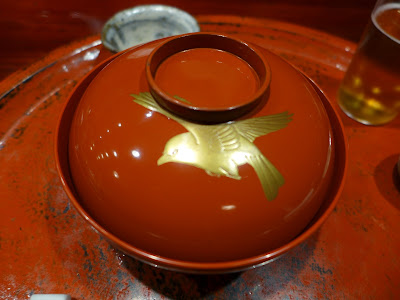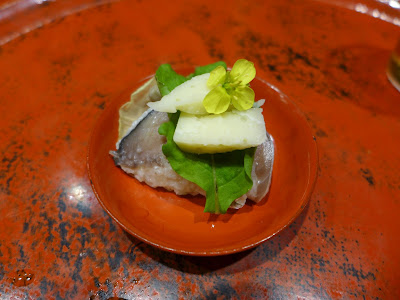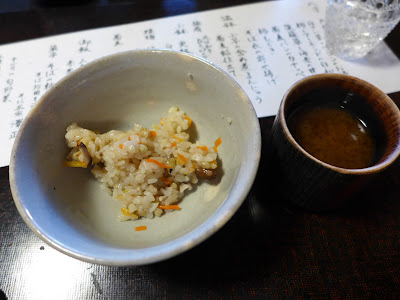Restaurants, Kyoto and Vicinity
Kyoto is a city of fabulous gardens, temples and shrines. There are over 2000 temples and shrines in the city. For more than a 1000 years, Kyoto was the Imperial city of Japan so it has an extraordinary history.
A portion of the Ryoanji garden, one of the gardens of this zen temple which was founded in 1450. Ryoanji temple is considered one of the finest examples of dry landscape gardens in the world.
A tea house in a Kyoto garden.
Tempura Matsu
Koppe crab, the female of the snow crab
The crab meat with water shield (junsai), an aquatic plant.
Presentation.
Tempura of kamo eggplant and shrimp, in a sandwich, with a bean, on a treasured ceramic plate created by Rosanjin, a noted early 20th century calligrapher and ceramist.
Presentation with sudachi lime.
Dobinmushi, with matsutake mushroom and clam in mushroom clam broth.
Sashimi of mackerel, squid and tile fish with soy sauce with sea weed.
Fried tile fish scales.
Broiled Spanish mackerel with soy sauce jelly.
Otoro slabs awaiting cutting. About $6000.00 worth.
Presentation of otoro (fatty tuna) and sticky rice.
Simmered octopus with Sansyo nuts.
Sukiyaki of burdock and pike eel.
Onion tempura.
Presentation.
Udon noodle in an ice bowl.
Roasted green tea ice cream.
Sojiki Nagahigashi
Sojiki Nakahagishi is a 2 michelin star kaiseki restaurant. The chef is the brother of the chef at the renown Miyamaso, a ryokan and restaurant in the mountain countryside north of Kyoto (covered later in this blog). The brothers feature the same type of cuisine which the call tsumikusa (freshly picked). Uniquely, it is typical for these chefs to walk in the mountains and trees and pick wild plants, fruits and vegetables from early every morning.
My sake cup.
Presentation.
Baby yam bulb and salmon roe with steamed rice.
Presentation.
Soup with white soy bean paste, a cake of pounded chestnuts, sliced radish and rice.
Presentation. Fried rice "ear" (like rice popcorn which you eat by removingthe puffed rice from the stem); Steamed peanuts; manji pepper; "jam" made from the special Japanese orange featured on the plate, which chef picked from the mountain wilds in the morning (wild orange!). Perhaps the greatest tasting orange I have ever enjoyed! I even wound up eating the skin and pulp! Note the fried ayu (sweetfish) spine lying on the husk.
Opening the husk above reveals the grilled ayu and soy bean paste. During this season the ayu is delightfully filled with its roe. The great orange is visible on the plate.
Wild beef (yes, there is such a thing) from Hokkaido (they eat only bamboo grass and wormwood grass), with sansho oil, sansho nuts, cep mushrooms, purple carrot and red and white radish.
Carp sashimi with boiled carp skin, fried carp scales, and carp bones with jelly, accompanied by house made soy sauce.
Presentation.
Soup: Large eel from Lake Biwa wrapped in radish with matsutake mushroom, yuzu and herb mustard.
I ate the top stuff to reveal the eel wrapped with the radish.
Fermented mackerel sushi. The fish had been fermented since may 2015. The topping is okura flower, akebi fruit and cheese made at Yoshida farm. Some if the cheeses I tasted in Japan were truly remarkable in their complex and interesting flavours.
Presentation with early red bean on the top.
Simmered turnip with yam, kintoki carrot, turnip grass, a mushroom that tasted remarkably like a black truffle.
Sukiyaki: featuring chicken raised by the chef, leek and konnyaku (elephant yam) (a paste was made from konnyaku flour).
Simmered daikon radish and fried soy bean curd.
Presentation.
Dried and grilled sardine.
Pickles of seaweed, baby turnip and radish.
Kashira potato with gion beans and manji pepper paste.
Hayato gourd with grilled shiitake mushrooms, oxalis and soy bean paste.
Crispy rice with sansho oil and salt.
Rice with hot water and plum paste.
Seasonal daishiro persimmon with carrot grass sorbet and chocolate stick.
Black sugar ball with buckwheat seeds and Japanese cheese.
Miyamiso
Miyamiso is a 2** michelin kaiseki restaurant but also a wonderful ryokan nestled in the mountains just north of Kyoto. I stayed overnight on my first trip to Japan 28 years ago and the overall experience was serene and sublime.
The chef is the brother of the chef at Sojiki Nagahigashi (covered above, in this blog). The brothers feature the same type of cuisine which the call tsumikusa (freshly picked). Uniquely, it is typical for these chefs to walk in the surrounding mountains and trees and pick wild plants, fruits and vegetables, early every morning to select wild ingredients for the evening's dinner guests.
The chef is the brother of the chef at Sojiki Nagahigashi (covered above, in this blog). The brothers feature the same type of cuisine which the call tsumikusa (freshly picked). Uniquely, it is typical for these chefs to walk in the surrounding mountains and trees and pick wild plants, fruits and vegetables, early every morning to select wild ingredients for the evening's dinner guests.
We were escorted to a private tatami mat covered room that had its own private balcony over an adjacent river. One could sit for hours listening to the rushing, gurgling sound.
The view from our tatami mat room, at the balcony.
Our private room (our tokomoma behind where we are seated) and adjacent balcony.
A close view of our own tokonoma (alcove),
where items for artistic appreciation are displayed.
Presentation: top: carp sashimi with grilled carp skin. Left: soup with white soy bean paste, soy bean curd filled with a black truffle tasting mushroom.
The soup.
Hassun (the second course of a formal kaiseki dinner which sets the theme for the rest of the meal): Chrysanthemum flower and leaves, marinated in soy sauce; egg yolk marinated in soy bean paste; fried river shrimp; water chestnut; boiled raw peanuts with salt; konnyaku flour formed into a jelly like ball made from the starch of devils tongue); cake made from pounded horse chestnuts and mochi rice; sweet potato chips shaped like a maple leaf.
Presentation: steamed glutinous rice with baby yam bulbs, lily bulb and shiitake mushrooms.
Rice, yam bulb, lily bulb and shiitake mushrooms.
The presentation of matsutake mushrooms and tile fish in broth.
Unwrapping the grilled cedar wrapped ayu which was full of roe in the belly of the fish.
My Tokyo "foodie" friend Kumi, "the great arranger"! Kumi is so knowledgeable about the food and sake and contributes her great understanding about the nuances of each meal.
Komuso mushroom (komuso means old monk. Their hats look like the top of the mushroom), marinated in vinegar with tomato sauce and malt.
My sake cup and sake.
Preparing the broth and veg.
A closeup of the pot contents revealing a mushroom, pointed out to me, with the shape of a claw.
Presentation of roasted chestnuts and rice.
Our chestnuts and rice dish with summer pickles (shibazuke): seaweed, hayato gourd and radish.
Seasonal persimmon topped with Japanese kiwi and persimmon leaf ice cream.
Cake made from pounded horse chestnuts and mochi rice.
An extraordinary kaiseki experience.
Nakamura
The entrance to Michelin 3*** kaiseki restaurant, Nakamura, in business for almost 200 years! Nakamura has only 4 tatami mat covered rooms for service.
Our private tatami mat room. Note the tokonoma with the hanging to be admired, on the left. The calligraphy above the screen is 19th century. At our dinner we were personally cared for by 2 kimono clad servers, one of whom was the owner/chef's wife, an important aspect of kaiseki cuisine.
Presentation.
Female snow crab with sperm and roe with citrus sauce made of a combination of yuzu and sudachi lime.
Presentation.
White soy soup (shiromiso isshisouden zouni....meaning secret [recipe] soup recipe passed down from father to son....it was indeed, for 6 (!!) generations), with rice cake and wasabi.
Presentation.
Sashimi of striped jack, chutoro (medium fat) tuna and squid.
Presentation.
Soup of matsutake mushrooms, potherb mustard and yuzu.
Hassun (a second course plated with a number of elements setting the seasonal theme for the meal): Kyoto chrysanthemum flower with sesame paste in a sudachi lime cup; ebiimo potato; an egg shaped like a rock; shrimp and lotus with sesame paste; skewered cucumber marinated in soy bean paste; Oumi (the region) konnyaku (a potato based flour with a texture between rice cake (mochi) and gelatin with a somewhat chewy composition); simmered ayu fish with its roe; snapper sushi; squid in salted ayu.
Presentation.
Steamed turnip soup with diced turnip, pickled ginger, bottarga, ginko nut, sea eel. millet bran, kikurage mushroom and lily bulb.
Presentation.
Grilled tilefish, one eats the meat first and then we poured a hot kombu seaweed broth over the remaining bones and skin and let it sit for a bit.
One then drinks the delicious broth, holding back the bones and skin with chopsticks.
Presentation.
Rice with matsutake mushrooms and pickles.
Seasonal persimmon.
Ueno
Ueno is very good udon noodle restaurant that has a constant line. We arrived early to avoid the long lines.
This udon noodle dish is made from mushrooms and chrysanthemums and is only made for a very limited period of time in this season. The delicious broth is made from from premium dry bonito from Kagoshima prefecture, dry soda bonito from Kochi prefecture, mackerel, sardine from Kumamoto prefecture, premium Kombu seaweed from Rishiri Island, Hokkaido and chicken. The odon for this dish is made from premium flour from Kagawa prefecture and flavoured with Setonai Sea salt.
This was one of the most delicious udon bowls I have ever experienced on my various trips to Japan. This resto is well worth visiting for lunch in Kyoto.
Mizai
Mizai is a Michelin 3*** kaiseki experience where everyone is obliged present at the restaurant at the very precise time of their assigned reservation. It is advisable to arrive at least 15 minutes early. Everyone is seated at an L-shaped counter for 16 guests, rather than in a private room. The head chef and assistants do the prep for each dish right in front of you and everyone is served at roughly the same time for each and every course. This is why one is expected to arrive a bit early. It is a ritual of this restaurant. Chef Hitoshi Ishihara introduces each course with his philosophy and the background of the ingredients in each dish.
No photographs were allowed, which was indeed unfortunate because the meal was so special.
We began with rice, then soup and one dish served in the tea ceremony style. The rice was from Shimane prefecture, the chef's birthplace.
Rice.
Soup: White soy bean paste with loyus dumpling and red beans from Tamba.
Persimmon marinated in vinegar with seaweed, radish, cucumber and thatched nuts.
Kintoki carrot leaves marinated in soy sauce and broth.
Sashimi:
snapper from Ehime prefecture, squid from Tsushima and ear and edge of squid with sesame paste.
Mackerel from Seki.
Tuna: two types, one from Canadian tuna (190KG catch) and one from Maizuru (north of Kyoto), a 15KG catch. It was served first with the inner skin and outer skin; soy sauce and seaweed jelly and ponzu, salt and citrus sauce.
Snapper liver.
Soup: minced quail dumpling, chestnuts, pine nuts and matsutake mushrooms from Tamba.
Japanese beef from Okuizumo was charcoal grilled and served with apple sauce, ripe Takagamine pepper and 5 kinds of vegetables, along with Japanese bee honey and citrus sauce.
Buckwheat dumpling was served with oyster.
Hassun (The second "course" whcih sets off the seasonal theme):
Fried prawn
Water chestnuts
Salmon roe
Sea eel in broth jelly
Scallop of pearl oyster with pickles and kochia sead
Manganji pepper and shrimp and small fish
White shrimp and Mozuku seaweed.
Snapper and turnip sushi.
Duck simmered in whiskey.
Pacific saury simmered in sancho pepper.
Yam tubers, smoked egg and simmered green soy beans.
Simmered Kyoto yum and herring.
Snow crab with paste.
Abalone with liver sauce.
Grilled barracuda.
Rice with soup.
Pickles: turnip, seaweed, Chinese cabbage, red turnip, raddish and turnip leaves.
Chestnut mocha with walnut.
40 kinds of fruits with soy bean ice cream and pear cream.
Paw paw sherbet with potato shocyu (distilled spirits) jelly and pomegranate jelly.
Hassun: Radish soup (top); Chinese cabbage and bacon marinated in broth (bottom left); Persimmon and almond with soy bean paste (top left): Spinach and vinegar with shrimp (top right); egg on buckwheat bread (top centre); Pumpkin shaped like persimmon (bottom right); deep fried veg with buckwheat (bottom centre).
Simmered small yam dumpling with shiitake mushroom, kikurage mushroom and konnyaku with buckwheat sauce.
Grilled beef from Ohmi and broiled scallop.
Buckwheat noodle made exclusively from the centre of buckwheat seeds, with pickled Chinese cabbage.
Grilled chicken and crispy buckwheat wth mushroom sauce.
Buckwheat noodles (80% millstone ground buckwheat; 20% flour) in a soup. The buckwheat is from the premium region Kuromatsunaicho in Hokkaido.
Cold Buckwheat noodles (80% millstone ground buckwheat; 20% flour) sith wasabe. The buckwheat is from the premium region Kuromatsunaicho in Hokkaido. accompanied by a light soy/ponzu sauce.
Rice with carrot, shiitake mushroom and buckwheat.
We began with rice, then soup and one dish served in the tea ceremony style. The rice was from Shimane prefecture, the chef's birthplace.
Rice.
Soup: White soy bean paste with loyus dumpling and red beans from Tamba.
Persimmon marinated in vinegar with seaweed, radish, cucumber and thatched nuts.
Kintoki carrot leaves marinated in soy sauce and broth.
Sashimi:
snapper from Ehime prefecture, squid from Tsushima and ear and edge of squid with sesame paste.
Mackerel from Seki.
Tuna: two types, one from Canadian tuna (190KG catch) and one from Maizuru (north of Kyoto), a 15KG catch. It was served first with the inner skin and outer skin; soy sauce and seaweed jelly and ponzu, salt and citrus sauce.
Snapper liver.
Soup: minced quail dumpling, chestnuts, pine nuts and matsutake mushrooms from Tamba.
Japanese beef from Okuizumo was charcoal grilled and served with apple sauce, ripe Takagamine pepper and 5 kinds of vegetables, along with Japanese bee honey and citrus sauce.
Buckwheat dumpling was served with oyster.
Hassun (The second "course" whcih sets off the seasonal theme):
Fried prawn
Water chestnuts
Salmon roe
Sea eel in broth jelly
Scallop of pearl oyster with pickles and kochia sead
Manganji pepper and shrimp and small fish
White shrimp and Mozuku seaweed.
Snapper and turnip sushi.
Duck simmered in whiskey.
Pacific saury simmered in sancho pepper.
Yam tubers, smoked egg and simmered green soy beans.
Simmered Kyoto yum and herring.
Snow crab with paste.
Abalone with liver sauce.
Grilled barracuda.
Rice with soup.
Pickles: turnip, seaweed, Chinese cabbage, red turnip, raddish and turnip leaves.
Chestnut mocha with walnut.
40 kinds of fruits with soy bean ice cream and pear cream.
Paw paw sherbet with potato shocyu (distilled spirits) jelly and pomegranate jelly.
Sawasho
Sawasho is known for it's soba presented kaiseki style, specifically buckwheat soba.
Hassun: Radish soup (top); Chinese cabbage and bacon marinated in broth (bottom left); Persimmon and almond with soy bean paste (top left): Spinach and vinegar with shrimp (top right); egg on buckwheat bread (top centre); Pumpkin shaped like persimmon (bottom right); deep fried veg with buckwheat (bottom centre).
Simmered small yam dumpling with shiitake mushroom, kikurage mushroom and konnyaku with buckwheat sauce.
Grilled beef from Ohmi and broiled scallop.
Buckwheat noodle made exclusively from the centre of buckwheat seeds, with pickled Chinese cabbage.
Buckwheat noodles (80% millstone ground buckwheat; 20% flour) in a soup. The buckwheat is from the premium region Kuromatsunaicho in Hokkaido.
Cold Buckwheat noodles (80% millstone ground buckwheat; 20% flour) sith wasabe. The buckwheat is from the premium region Kuromatsunaicho in Hokkaido. accompanied by a light soy/ponzu sauce.
Rice with carrot, shiitake mushroom and buckwheat.
Buckwheat mochi filled with persimmon, sided with buckwheat cracker.












































































































No comments:
Post a Comment